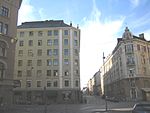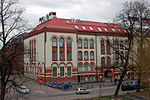Helsinki Finnish Methodist Church
Churches in HelsinkiEuropean church stubsFinnish religious building and structure stubsMethodist congregations in FinlandPunavuori

The Helsinki Finnish Methodist Church (also known as the Helsinki Finnish Methodist Congregation; Finnish: Helsingin metodistiseurakunta; Finnish: Helsingfors finska metodistförsamling) is a Finnish Methodist congregation in Helsinki, Finland. It belongs to the Finnish Methodist Church and was founded in 1894. The current congregation building is located in the Punavuori district of Helsinki. The congregation regularly organizes bilingual worship activities; mission circles, Bible evenings, moments of prayer and youth evenings also meet regularly in the congregation.Helsinki also has another, Swedish-speaking Methodist congregation.
Excerpt from the Wikipedia article Helsinki Finnish Methodist Church (License: CC BY-SA 3.0, Authors, Images).Helsinki Finnish Methodist Church
Punavuorenkatu, Helsinki Punavuori (Southern major district)
Geographical coordinates (GPS) Address Phone number Nearby Places Show on map
Geographical coordinates (GPS)
| Latitude | Longitude |
|---|---|
| N 60.161711111111 ° | E 24.939641666667 ° |
Address
Ompelimo Ann-Lei
Punavuorenkatu 2
00120 Helsinki, Punavuori (Southern major district)
Finland
Open on Google Maps











